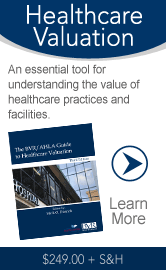 |
 |
Issue #27-1 | September 18, 2014

Joan Rivers case points up risks Buyers and operators of ambulatory surgical centers (ASCs) need to be aware of potential serious risks these entities face, especially with older patients who represent a major segment of ASC customers. The recent high-profile case of Joan Rivers illustrates this, as her visit to an endoscopy clinic for a routine procedure ended up launching her into a death spiral. The clinic’s medical director has been forced out, and the state’s health department is investigating the case. Lots of interest: Market activity is high for ASCs. There is strong demand for acquisitions, both from the provider community (e.g., hospitals) and private equity firms. Customer demand for outpatient surgery is expected to increase, driven by growth in the population of individuals age 55-plus, who are key customers of this business. In addition to treatment-related risks, there are other risks ASC investors need to understand. Fortunately, there’s some help in this area. ASC risk assessment tool: In a recent BVR webinar, Todd Sorensen and Kevin McDonough (both with VMG Health) discussed the valuation of ASCs and presented a tool for assessing the risks inherent in ASCs. The ASC Risk-Assessment Matrix, developed by Jon O’Sullivan of VMG Health, measures risk along a number of lines, including service-area growth, competition, location, physician ownership, and more. The tool produces a single score but gives different weights to different categories and subcategories based on their relative importance to measuring risk. The weighting may be adjusted based on specific facts and circumstances, but, typically, the highest weights are assigned to categories that directly affect volume and reimbursement expectations (e.g., the physician utilization profile, market reimbursement risk analysis, and market competition). Snapshot view of how health reform impacts valuation Health reform has resulted in a maze of new laws, regulations, and mandates that all have their effect on the valuation of healthcare providers, particularly hospitals. During a recent BVR webinar, Don Barbo (Deloitte Financial Advisory Services LLP) and Robert Mundy (Pershing Yoakley & Associates P.C.) gave a rundown of the current status of the major healthcare reform measures and their potential impact on the values of entities in this industry. Free download: They also provide a very interesting chart that examines various types of healthcare entities and the potential impact health reform has on the four key areas affecting valuation: profitability, growth, risk, and marketability. The entities covered include acute care hospitals, physician practices, rehab facilities, ASCs, imaging centers, and others. For a copy of this chart, titled "Potential Impact of Health Reform on Various Healthcare Provider Business Models," go to BVR’s Free Resources page. An archived version of Barbo and Mundy’s webinar, “Hospital Valuations,” is available here. Healthcare services sector trading performance and multiples The S&P Healthcare Services Index “has increased by 11.1% over the last three months [May 2014-July 2014], significantly outperforming the S&P 500,” according to the August 2014 Healthcare Sector Update from Duff & Phelps. The best-performing sectors were acute care hospitals (up 25.7%) and home care/hospice (up 17.7%); the worst-performing sectors were emergency services (down 5.9%) and other services (down 4.6%), says the report. Latest multiples: The current median LTM revenue and LTM EBITDA multiples for the healthcare services industry overall are 1.67x and 11.0x, respectively. The sectors with the highest valuation multiples include: consumer-directed health and wellness (4.57x LTM revenue, 26.7x LTM EBITDA) and HCIT (3.55x LTM revenue, 16.0x LTM EBITDA). The report also provides data on the pharmaceutical/medical devices/life sciences sector. Healthcare M&A spending is up 171% in 2Q14 over 1Q14Spending on healthcare M&A hit a new record in the second quarter of 2014, according to Health Care M&A News. The combined total for M&A activity in the second quarter reached $135.2 billion, up 171% compared with the first-quarter spending total ($49.9 billion). M&A spending is up 152% versus the same period in 2013. Tech is hot: The vast majority (91%) of combined M&A spending came from transactions on the healthcare technology side, while healthcare services contributed the remainder (9%). Dollar volume for technology exploded by 229% over the first quarter of this year. Dollar volume for services was down 3% compared to the first quarter. “Now that the health information exchanges are functioning, investors have decided that health care is a good place to be,” says Lisa E. Phillips, editor of Health Care M&A News. “The equity markets are still rewarding the big deal makers, as well. At this point, it looks as if this momentum could carry well into the third quarter.” New bill would standardize hospital M&A reviews New proposed legislation would require the Federal Trade Commission to follow the same procedure as the Department of Justice when reviewing mergers and acquisitions of hospital and health systems. It would require the FTC to exclusively use the federal courts to review mergers, rather than using administrative litigation in addition to preliminary injunctions in federal court. Unfair play: The bill, The Standard Merger and Acquisition Reviews Through Equal Rules Act of 2014, has the backing of the American Hospital Association. In a letter to members of the House Judiciary Committee, AHA Executive Vice President Rick Pollack says the current FTC review methodology is "unfair and punitive" and amounts to "double jeopardy" for hospitals. Companies in industries that fall under the FTC’s jurisdiction typically face a tougher merger challenge than those in sectors that the DOJ covers. The new bill would eliminate this perceived unfairness by aligning the M&A tests of the two agencies. Federal appeals court to rehear case on ACA tax subsidies The full U.S. Court of Appeals for the District of Columbia Circuit will rehear a case on Affordable Care Act tax subsidies that could eliminate conflicting rulings over this matter. The outcome could have an effect on the number of newly insured individuals, which could impact the number of patients a healthcare provider treats. Without the subsidy, individuals may not be able to afford the insurance and opt to pay the penalty for being uninsured. Split decisions: The dispute centers on whether the subsidies, in the form of tax credits, apply to consumers only in the states that have set up insurance marketplaces or to the much larger group of people who buy insurance on the federal marketplace. The question before the court involves tax subsidies that apply to more than half of the 8 million people who picked an insurance plan from October 2013 through mid-April 2014. Earlier this year, the D.C. Circuit, in Halbig v. Burwell, ruled that individuals who buy the insurance through a federal exchange are not entitled to the subsidy. Two hours later, the 4th Circuit, in King v. Burwell, issued a contradictory ruling, saying an individual who qualifies can receive the subsidy regardless of whether the insurance is purchased from a state-sponsored or federal exchange. Healthcare CIOs look to analytics for quality and cost improvements The top IT investment priority for healthcare CIOs is analytics software and solutions, according to a recent survey. This technology is key to achieving the quality improvements and cost reductions mandated by healthcare reform. Wish list: Over half (54%) of 70 members of the College of Healthcare Information Management Executives (CHIME) rate data analytics as their highest IT priority. Other top priorities included population health initiatives, ICD-10, accountable care initiatives, and consolidation-related IT investments. The survey was conducted by Health Catalyst, a provider of data solutions. EMRs hurt physician productivity, says new research When planning policies and procedures for electronic medical record systems (EMRs), you may be causing productivity problems. Physicians say they lose an average of 48 minutes of free time per clinic day due to EMRs, according to a research letter in the Journal of American Medical Association, Internal Medicine. Wasted time: The average 48-minute time loss for attending physicians equates to four hours for a five-day clinic week. However, 59.4% of all surveyed physicians, including residents and fellows, reported an average 78-minute time loss per clinic day, or 6.5 hours for a five-day clinic week, according to the research letter. Webinars of interest BVR’s ongoing Online Symposium on Healthcare Valuation focuses on the challenges inherent in valuations in medicine, life sciences, and healthcare. Here are some upcoming webinars in this series:
|
|
||||||
Business Valuation Resources, LLC
1000 SW Broadway, Suite 1200, Portland, OR 97205
(503) 291-7963 | editor@bvhealthcarenews.com
bvresources.com/healthcare

